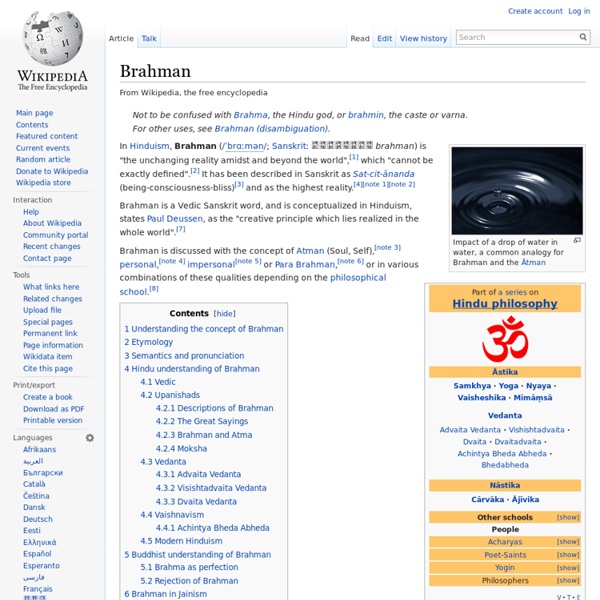Brahma
Etymology[edit] In Sanskrit grammar, the noun stem brahman forms two distinct nouns; one is a neuter noun bráhman, whose nominative singular form is brahma ब्रह्म; this noun has a generalized and abstract meaning. Contrasted to the neuter noun is the masculine noun brahmán, whose nominative singular form is brahmā ब्रह्मा. This noun is used to refer to a person, and as the proper name of a deity Brahmā it is the subject matter of the present article. Origin[edit]
Vaishya
Traditional duties[edit] Hindu religious texts assigned Vaishyas to traditional roles in agriculture and cattle-rearing but over time they came to be landowners, traders and money-lenders.[1] The Vaishyas, along with members of the Brahmin and Kshatriya varnas, claim "twice born" (dvija) status in Hindu theology.[2] Indian traders were widely credited for the spread of Indian culture to regions as far as southeast Asia.[3] Historically, Vaishyas have been involved in roles other than their traditional pastoralism, trade and commerce. According to Ram Sharan Sharma, a historian, the Gupta Empire was a Vaishya dynasty that "may have appeared as a reaction against oppressive rulers".[4] Modern communities[edit] References[edit]
Baal
Bronze figurine of a Baal, ca. 14th–12th century BC, found at Ras Shamra (ancient Ugarit) near the Phoenician coast. Musée du Louvre. "Baal" may refer to any god and even to human officials. In some texts it is used for Hadad, a god of thunderstorms, fertility and agriculture, and the lord of Heaven.
The Dagda
Description[edit] Despite his great power and prestige, the Dagda is sometimes depicted as oafish and crude, even comical, wearing a short, rough tunic that barely covers his rump, dragging his great penis on the ground.[1] Such features are thought to be the additions of Christian redactors for comedic purposes. Tellingly, the Middle Irish language Coir Anmann (The Fitness of Names) paints a less clownish picture: "He was a beautiful god of the heathens, for the Tuatha Dé Danann worshipped him: for he was an earth-god to them because of the greatness of his (magical) power.
Jnana
Jnana or gnana or gnaan (Sanskrit; Pali: jñāna) is a Sanskrit word that means knowledge. It has various nuances of meaning depending on the context, and is used in a number of different Indian religions. The idea of jnana centers around a cognitive event which is recognized when experienced.[1] It is knowledge inseparable from the total experience of reality, especially a total reality,[1] or supreme being within Mahesha-dhama (and/or material world) such as Siva-Sakti.[2] Absence of jnana (knowledge, gnosticism) is known as ajnana (see: agnosticism): Famous mantra in this relationship says: "Om ajnana timirandhasya..." (I was born in ajnana, agnosticism, but my spiritual master opened my eyes with fire of transcendental knowledge, jnana).
El (deity)
El, seated on a throne with lion feet, wears conical horned headdress, a tunic and mantle. He receives gifts from a priest or king or lesser deity. The winged globe is above them in the background. Stele found in Palestine.[1][2] ʾĒl (written aleph-lamed, e.g. Ugaritic: 𐎛𐎍, Phoenician: 𐤋𐤀,[3] Classical Syriac: ܐܠ, Hebrew: אל, Arabic: إل or إله, cognate to Akkadian: ilu) is a Northwest Semitic word meaning "deity".
Kshatriya
The Sanskrit term Kshatriya belonged to the Vedic society wherein members organized themselves into 3 classes: Brahmin, Kshatriya, and Vaishya.[1] Traditionally, Kshatriya constitute the ruling and military elite. They were in charge of the protection of the society by fighting in wartime and governing in peacetime. Origins[edit] Early Rigvedic tribal chiefdom[edit]
Enlil
Enlil with his wife, Ninlil Origins[edit] Enlil was known as the inventor of the mattock (a key agricultural pick, hoe, ax or digging tool of the Sumerians) and helped plants to grow.[5] Cosmological role[edit] Enlil, along with Anu/An, Enki and Ninhursag were gods of the Sumerians.[6]



